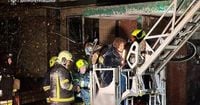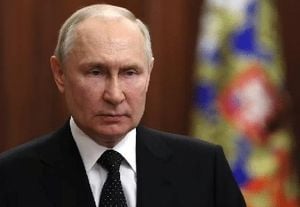In a chilling escalation that underscores the relentless nature of the ongoing conflict, Russian forces unleashed a sweeping wave of drone and missile attacks across Ukraine from November 8 through November 10, 2025, striking multiple regions and leaving a trail of destruction, civilian casualties, and fresh fears for the country’s battered energy infrastructure. As winter tightens its grip and diplomatic efforts stall, Ukraine’s leaders are renewing urgent calls for advanced Western air defense systems, arguing that only a dramatic boost in protection can shield civilians and critical infrastructure from the onslaught.
According to Ukraine’s Air Force, the latest barrage began in the early hours of November 10, with Russian forces launching a staggering 67 long-range drones—primarily Shahed and Gerbera models—from various directions, including Russia’s Kursk, Millerovo, Oryol, Bryansk oblasts, and from occupied Crimea. The air assault was complemented by two Kinzhal aeroballistic missiles fired from over Tambov Oblast, and five S-300/S-400 surface-to-air missiles from Kursk. Ukrainian air defense units responded with a coordinated effort, downing or jamming 52 drones by 9:30 a.m., but 15 drones still slipped through to strike targets across the country. The attacks, as reported by Euromaidan Press, resulted in civilian injuries, fatalities, and widespread infrastructure damage.
Sumy Oblast was among the hardest hit, with two women injured in separate communities. Local police and the oblast administration reported that a 45-year-old woman was hurt in Velykopysarivska, while an 89-year-old woman was hospitalized after a drone struck Krasnopilska. The strikes also damaged three apartment buildings, seven single-family homes, warehouses, garages, power lines, and vehicles across six communities. In Kharkiv Oblast, two women were wounded when drones hit the village of Prykolotne, damaging at least ten detached homes and other structures, according to the oblast prosecutor’s office.
The violence was not confined to these regions. In Kherson Oblast, a 26-year-old man lost his life when a short-range drone dropped explosives on a residential street in Stanislav on November 9. Law enforcement has launched a war crimes investigation into the incident. Two women in the same oblast—a 49-year-old scientific institution employee and a 59-year-old resident—were also hospitalized with injuries from separate shelling attacks. Donetsk Oblast saw two civilians injured in Russian attacks, including a Granat-4 drone strike on Sloviansk that damaged a two-story apartment building and a vehicle.
Odesa faced its own crisis when a drone ignited the facade of a four-story residential building on November 10. Firefighters managed to extinguish the flames quickly; fortunately, no injuries or deaths were reported, according to Odesa Oblast head Oleh Kiper. In Dnipropetrovsk Oblast, Russian strikes sparked fires in Nikopol and the Pokrovska community, and a drone attack set a church ablaze and damaged a bank building in Vasylkivska. Again, no injuries were reported, but the psychological toll of these attacks is mounting.
Zaporizhzhia Oblast endured an astonishing 367 Russian strikes in just 24 hours, including airstrikes, 162 FPV drone attacks, multiple-launch rocket system barrages, and artillery strikes across 13 localities, as relayed by oblast head Ivan Fedorov. Khmelnytskyi Oblast was also attacked, but authorities there said no casualties or damage occurred.
The violence escalated further on the evening of November 10, when an FPV drone struck Kostiantynivka, killing a civilian man as he rode his motorcycle. The head of the city’s military administration, Serhiy Gorbunov, told Radio Liberty that law enforcement documented the crime and evacuated the victim. Gorbunov urged residents to avoid dangerous areas and follow evacuation procedures, highlighting the constant threat facing civilians. Russian forces continue to use a mix of weapons—strike drones, missiles, artillery systems including KABs and MLRS—to attack Ukrainian regions, a pattern that Ukrainian authorities and international organizations classify as war crimes, despite Russian denials of targeting civilian infrastructure.
These attacks have had a devastating impact on Ukraine’s energy grid. Most regions are now enduring scheduled power outages, with Ukrenergo, the state-run electricity operator, warning that blackouts could last at least until the end of Monday, November 10, as crews scramble to repair infrastructure damaged over the weekend. The Poltava and Kharkiv regions are particularly hard-hit, suffering from deficits in high-voltage capacity due to transmission line damage, while Dnipropetrovsk, Zaporizhia, Kyiv, and other central and northern regions are also affected. The onset of winter only heightens the urgency.
As reported by Al Jazeera, Ukraine’s military confirmed that Russian forces used two air-launched ballistic missiles, five surface-to-air guided missiles, and 67 drones—including Iranian designs—overnight into Monday. While 52 drones were intercepted, 15 struck nine locations, causing further disruption. Russia, meanwhile, claimed its air defenses shot down six US-made HIMARS rockets and 124 fixed-wing UAVs, and destroyed four naval drones near the Black Sea port. Ukraine has also been targeting Russian oil and fuel infrastructure, with an explosion reported in Russia’s port town of Tuapse after Ukrainian sea drones were launched at a major oil terminal. No casualties were reported in that incident.
President Volodymyr Zelenskyy has seized on the latest attacks to renew his appeals for Western assistance. On November 9 and 10, he emphasized the urgent need for Patriot air defense systems, stating, "It is precisely because of such attacks that we pay special attention to Patriot systems—to be able to protect our cities from this horror." Zelenskyy has called for the purchase of 25 Patriot systems from US manufacturers, suggesting that European countries could transfer their own systems to Ukraine and await replacements. He has also urged America to expand sanctions on Russian oil and provide long-range missiles. During talks in London hosted by British Prime Minister Keir Starmer, European leaders pledged military support focused on protecting Ukraine’s power grid and improving air defenses as winter approaches.
The human toll of these attacks is staggering. Early on November 9, a Russian drone slammed into an apartment building in Dnipro, killing three people—including two children—and wounding 12 others, according to Associated Press. A worker at an energy company in Kharkiv was also killed. Fires broke out, apartments were destroyed, and rescuers recovered bodies from the rubble. The attacks are part of what Ukrainian officials describe as an attempt to "weaponize winter," aiming to cripple the power grid and deny civilians heat, light, and water. Ukrainian Prime Minister Yulia Svyrydenko reported that several major energy facilities around Kharkiv, Kyiv, and the central Poltava region were damaged in these strikes.
Meanwhile, fighting for the strategic city of Pokrovsk in Donetsk has intensified, with both Kyiv and Moscow seeking to demonstrate battlefield momentum as they vie for international support. Russian forces claim to have encircled Ukrainian defenders in key areas, though these statements have not been independently verified.
Elsewhere, the International Atomic Energy Agency reported that Ukraine’s Zaporizhzhia Nuclear Power Plant, located in Russian-controlled territory, has been reconnected to the grid after a month on diesel backup generators. The plant requires reliable power to cool its reactors and spent fuel, and has lost external power on multiple occasions since the full-scale invasion began.
As the war grinds on and the humanitarian crisis deepens, Ukraine’s leadership is adamant that only a significant boost in Western air defense capabilities—and a renewed focus on energy security—can help the country weather the storm of Russian attacks. The stakes, as the past week has made painfully clear, could not be higher.





